博文
NC文章详解 | 鼠成纤维细胞单细胞分析发现成纤维细胞在心肌细胞成熟中起关键作用
||
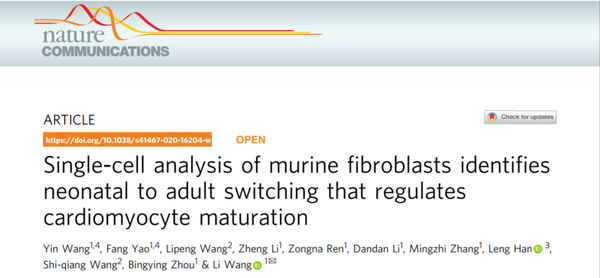
Cardiac maturation lays the foundation for postnatal heart development and disease, yet little is known about the contributions of the microenvironment to cardiomyocyte maturation. By integrating single-cell RNA-sequencing data of mouse hearts at multiple postnatal stages, we construct cellular interactomes and regulatory signaling networks. Here we report switching of fibroblast subtypes from a neonatal to adult state and this drives cardiomyocyte maturation. Molecular and functional maturation of neonatal mouse cardiomyocytes and human embryonic stem cell-derived cardiomyocytes are considerably enhanced upon co-culture with corresponding adult cardiac fibroblasts. Further, single-cell analysis of in vivo and in vitro cardiomyocyte maturation trajectories identify highly conserved signaling pathways, pharmacological targeting of which substantially delays cardiomyocyte maturation in postnatal hearts, and markedly enhances cardiomyocyte proliferation and improves cardiac function in infarcted hearts. Together, we identify cardiac fibroblasts as a key constituent in the microenvironment promoting cardiomyocyte maturation, providing insights into how the manipulation of cardiomyocyte maturity may impact on disease development and regeneration.
写在前面
利用单细胞转录组测序对成纤维细胞的分析其实蛮多的,一般可以分为两类,一类是在肿瘤微环境中,一类在骨髓细胞形成过程中。当然原因也是不言而喻,成纤维细胞在肿瘤中可以通过分泌大量生长因子和改变基质结构从而达到促进肿瘤生长的目的,体外实验观察到肿瘤细胞在成纤维细胞条件培养液中侵袭力增强,而成纤维细胞在骨髓中不仅起支持作用,而且分泌体液因子,调节造血细胞的增殖与分化。
2020年5月22日,中国医学科学院阜外医院团队在Nature Communications上发表题为Single-cell analysis of murine fibroblasts identifies neonatal to adult switching that regulates cardiomyocyte maturation的研究内容,发现成纤维细胞在心肌细胞成熟中起到至关重要的作用,与成年成纤维细胞共培养后,新生小鼠心肌细胞和人胚胎干细胞衍生的心肌细胞的分子和功能成熟度均大大提高,该研究对心脏疾病及心肌再生提供了新见解。
研究背景
心肌细胞属于终末分化细胞,缺乏增殖能力对心肌损伤进行修复,在外源性心脏重建过程中多能干细胞衍生的心肌细胞由于其尚未成熟的特质导致许多不良反应如心律不齐和畸胎瘤形成;
与胎儿心脏发育相比,产后心脏发育成熟的研究较少;
细胞微环境在物理空间和生物化学中对调节细胞命运起到重要作用,比如3D培养空间下人类胚胎干细胞衍生的心肌细胞的成熟性增强,但在生物化学方面研究较少;
产后心脏发育的研究为了解细胞微环境的变化及其对心肌细胞成熟的影响提供线索。
研究方案
Sample:C57BL/6 mice,出生后第(P)1、4、7、14和56天,心脏左心室细胞(其中P1、4、7、14均来自公共数据)。部分成人心肌细胞。
研究路线
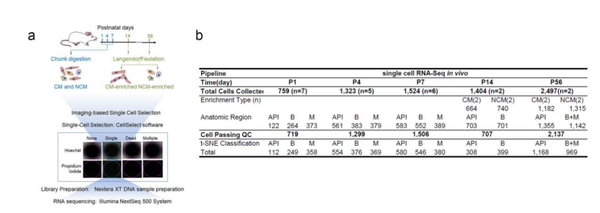
测序数据分析介绍
工具: MultiSample NanoDispenser (MSND, Wafergen Biosystems)
比对: UCSC mm10 genome
筛选: For cell filtering, the number of captured transcripts per gene was inferred based on UMIs, and all read pairs with UMIs containing Ns were excluded.Only cells with a minimally detected gene number of 500 were kept for downstream analysis. To remove background signal, only genes detected in at least ten cells were considered as passing the threshold. In addition, reads mapped to all 37 mitochondrial genes were excluded. Then, cells were filtered with genome alignment percentage over 50%, and distinct UMI number less than 1e6, and between the average distinct UMI number ±2* standard deviation across all the cells.
降维聚类: Seurat package (v2.1.0) ,PCs=10,resolution=1。
数据整合:CCA
测定batcheffect(特色分析):作者使用107个管家基因,包括37个tRNA基因、36个转录延伸因子基因、19个RNA聚合酶II亚基基因和15个核糖体基因,并通过scater(1.10.1)、SingleCellExperiment(1.4.1)和scran(1.8.4)构建了single cell experiment object,在PCA分析中发现所有组都是混合的,并且作者去除了在tsne中只在单个样本中出现的cluster,保证去除由于系统的技术问题导致的差异。
伪时序分析:Monocle2 (v2.6.0)
细胞间相互作用网络分析:通过UniProt database检索分泌蛋白基因作为配体,通过KEGG构建通路基因间的网络图。
配受体结合:STRING database 。
结果分析
小鼠出生后心脏发育的单细胞分析
研究人员一共选择了5个时间点,分别为出生后第(P)1、4、7、14和56天,其中P1、4、7、14均有公共的单细胞数据,所以作者只取了P56小鼠左心室进行单细胞测序,共获得2497个细胞(包括心肌细胞(cardiomyocytes,CMs)和非心肌细胞(non-cardiomyocytes,NCMs)。图1a-c对不同时间点的数据进行整合,共发现了7类细胞,包括心肌细胞(cardiomyocytes,CMs),内皮细胞(endothelial cell,EC),成纤维细胞(fibroblast,FB),巨噬细胞(macrophage,MP),平滑肌细胞(smooth muscle cell,SMC),T细胞(TC)和粒细胞(granulocyte,GR)。
通过伪时序分析发现,在心肌细胞state 1主要由P1,P4和P7构成,P14与P56在伪时序中分成多个状态,state 2和7主要由P14构成,state 8和9主要由P56构成(图1d-f),而state 6由P14与P56共同构成。图1g-1j显示在GO富集分析(GO、GSEA富集分析一网打进)中state 1主要与RNA剪接、细胞周期相变有关, States 2 和7主要与心肌发育相关,States 8和9与心脏收缩和ATP代谢过程有关。
在进行KEGG富集分析(Pathview包:整合表达谱数据可视化KEGG通路)中,作者发现从P1-P56中识别了许多与成熟相关的信号通路,如趋化因子信号途径、细胞因子-细胞因子受体相互作用、ECM-受体相互作用等(图1k)。总之,以上发现均证明了心肌细胞成熟过程中的复杂性。
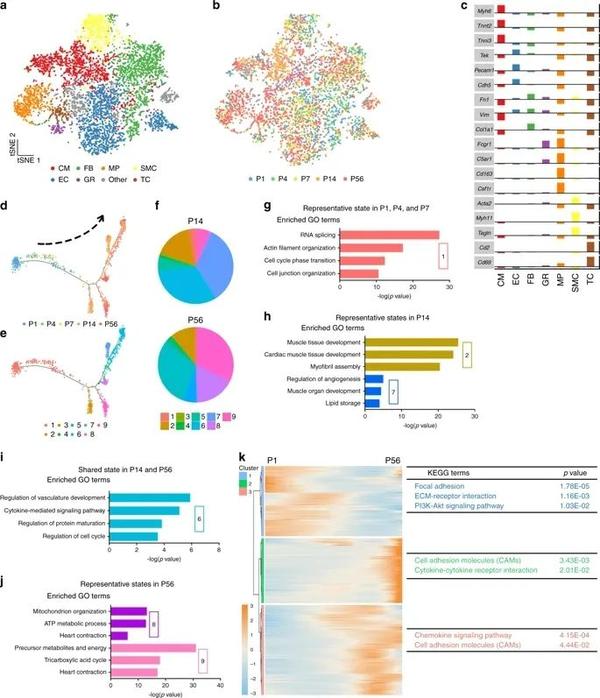
a, b t-distributed stochastic neighbor embedding (t-SNE) clustering of single cells from postnatal day 1 (P1), P4, P7, P14, and P56 hearts. CCA was applied to remove batch effects. Cells were colored by cell type (a) or time point (b). CM cardiomyocyte, EC endothelial cell, FB fibroblast, MP macrophage, SMC smooth muscle cell, TC T cell, GR granulocyte.c Cell populations in a were identified by the expression of established marker genes.d, e Monocle analyses showing the ordering of CMs in pseudotime. Each color indicates either a time point (d) or a cell state (e).f State proportions of CMs from P14 or P56 hearts, respectively.g–j Gene ontology (GO) analysis of genes specifically expressed in a given CM state from e. Selected top categories are shown here (Supplementary Data 1(https://www.nature.com/articles/s41467-020-16204-w#MOESM4)–[6](https://www.nature.com/articles/s41467-020-16204-w#MOESM9)).k Heatmap to display different blocks of top 1000 differentially expressed genes (DEGs) along the pseudotime trajectory (d, e). Please see Supplementary Data 7(https://www.nature.com/articles/s41467-020-16204-w#MOESM10) for the full list. Right: selected top Kyoto Encyclopedia of Genes and Genomes (KEGG) terms related to corresponding DEGs in blocks significantly changed during cardiomyocyte maturation (P1–P56), Functional analysis was performed with enrichKEGG in clusterProfiler, p < 0.05 was considered significant enrichment.
心脏成纤维细胞作为促成熟因子的预测
为了探究细胞微环境对心肌细胞(CM)成熟的影响,作者对不同时间点的非心肌细胞的比例变化进行分析,发现不同时间点下的细胞比例相差较大(图2a-2e)。然后识别影响非心肌细胞中比例变化的可分泌蛋白的基因,发现相关通路对心肌细胞成熟具有直接影响(图2f-2g)。在细胞亚型中,成纤维细胞亚型4和5(FB_4,FB_5)在P56中的分泌信号增加,而MP_3和FB_1在P56中的分泌信号减少(图2h-2i)。同样,成纤维细胞亚型(FB_1,FB_4,FB_5和FB_3)拥有最大数量的分泌蛋白基因,这些蛋白可能通过配体-受体相互作用而影响心肌细胞(图2k)。
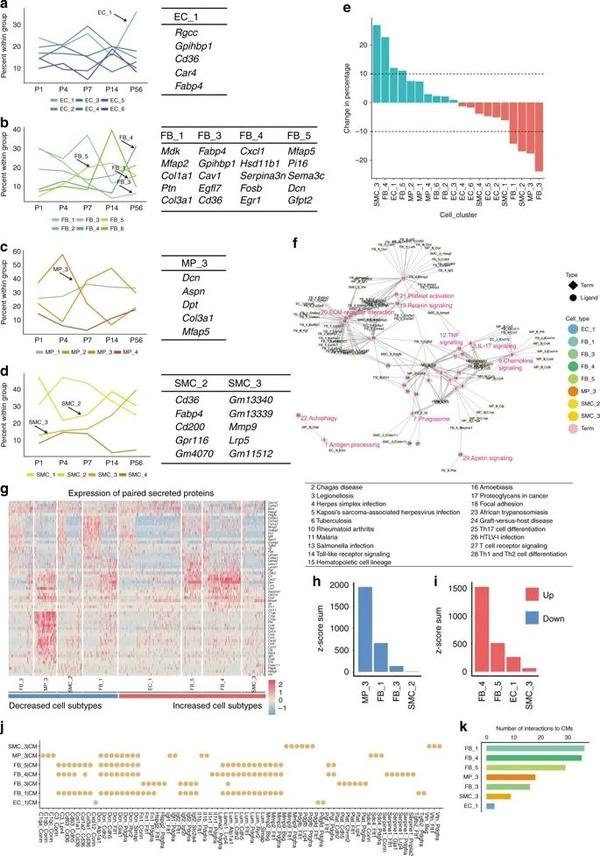
a–d Subtype distribution of EC (endothelial cell, a), FB (fibroblast, b), MP (macrophage, c) and SMC (smooth muscle cell, d) across different stages. The total number of cells at each time point was taken as 100%. Arrows indicate cell subtypes with significantly changed proportions in P1 versus P56 hearts (see “Methods”). Right: selected top genes in cell subtypes apparently changed in P56 vs. P1 hearts, respectively. Please see Supplementary Data 8(https://www.nature.com/articles/s41467-020-16204-w#MOESM11)–11(https://www.nature.com/articles/s41467-020-16204-w#MOESM14) for the full lists of genes in each cell subtype.e Ratio changes of altered cell clusters in P56 vs. P1. Dash lines indicate 10% cutoff which was used to define significantly changed cell subtypes in subsequent analyses (Supplementary Data 12(https://www.nature.com/articles/s41467-020-16204-w#MOESM15)).f Correlation analysis to show potentially matched pairs between the significantly altered genes encoding secreted proteins in representative cell clusters and signaling pathways in CM maturation during P1–P56 heart development. Each pink diamond represents signaling pathway (Supplementary Data 13(https://www.nature.com/articles/s41467-020-16204-w#MOESM16)). Each circle/dot indicates a secretory protein from a given cell type. Each connecting line indicates the correlation between a given secretory protein and a specific pathway.g Heatmap displaying the expression of genes in the correlation analysis (f) across all representative cell clusters (Supplementary Data 14(https://www.nature.com/articles/s41467-020-16204-w#MOESM17)).h, i Sum of all matched ligands (f) expressed in increased (i) or decreased (h) cell subtypes, respectively.j Bubble chart to show putative ligand–receptor pairs between differentially expressed receptors in CM clusters and corresponding ligands in significantly changed cell types (g).k Quantification of ligand–receptor pair counts (j) in each cell type.
随着时间的推移,成纤维细胞中编码可能促进成熟的蛋白质(包括Dcn、Lamc1,Pgf和Lama2)的基因的表达逐渐增加,而管家基因(例如Eif5和Rpl34)的表达则保持不变甚至适度减少(图3a)。然后作者通过免疫染色对FB_3用FABP4进行标记,FB_4使用EGR1进行标记,与单细胞测序相一致的是在P56心脏中FB_3的显著减少和FB_4的增加(图3b-3e)。在进行伪时序分析时,发现成纤维细胞的成熟与细胞外基质组织、BMP信号通路、肌肉器官形态发生等功能相关,从而增强了成纤维细胞在心脏成熟中的作用。综上所述,成纤维细胞亚型在产后心脏发育中从新生儿状态转变为成熟状态是促进体内CM成熟的主要驱动力。
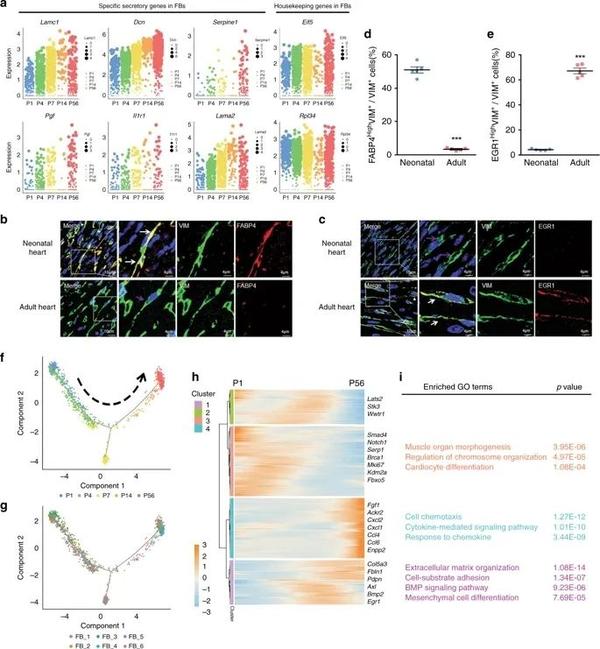
a The expression of selected ligands potentially involved in CM maturation or housekeeping genes in FBs during maturation.b, c Immunofluorescent staining of VIM and FABP4 (b) or EGR1 (c) in neonatal (P1) or adult (P56) heart sections, respectively. White arrows indicate co-localization, purple arrows indicate VIM+ only cells. Scale bars = 10 or 4 μm.d, e Quantification of VIM+FABP4High (d) or EGR1High (e) cells in heart sections from P1 or P56 mice, Data are plotted as mean ± SEM, n = 5 biologically independent mice, p < 0.001, two-sided Student’s t-test.f, g Monocle analyses showing the ordering of FBs in pseudotime. Each color indicates either a time point (f) or a cell state (g).h Heatmap to display different blocks of top 1000 differentially expressed genes (DEGs) along the pseudotime trajectory (f, g). Please see Supplementary Data 17(https://www.nature.com/articles/s41467-020-16204-w#MOESM20) for the full list.i Selected top gene ontology (GO) terms related to corresponding DEGs (Supplementary Data 18(https://www.nature.com/articles/s41467-020-16204-w#MOESM21)–20(https://www.nature.com/articles/s418467-020-16204-w#MOESM23)). Functional analysis was performed with enrichGO in clusterProfiler, p < 0.05 was considered significant enrichment. Source data are provided as a Source Data file.
成年心脏成纤维细胞促进新生儿心肌细胞的成熟
为了检验假设,作者使用了体外共培养系统,将从新生儿(P1)心脏分离的未成熟心肌细胞(imCM )与分别从新生儿心脏(NF)或成年心脏(AF)分离的成纤维细胞共培养 (图4a)。培养三天半后,NF共培养物中pH3+ -imCMs的比例(表明增殖)保持64.35%,而AF共培养中增殖的imCMs比例仅降低至5.32%(图4b,c)。同样,与NF共培养相比,AF共培养中的AURKB+和MKI67+ -imCMs的百分比也显着较低。这些结果表明,AF诱导的imCMs退出细胞周期,表明成熟度增加。
除了增殖减少外,成熟细胞形态和亚结构的获得也被认为是CM成熟的另一个标志,根据细胞形态和细丝排列可将其分为I–IV类,对应于从高到低的成熟状态。和少量增殖一致,与AF共同培养的imCM大多表现出拉长的形态和排列良好的细丝(I类和II类),而与NF共同培养的imCM则呈现出圆形的形态,带有杂乱甚至模糊的细丝(图4d–f)。
CMs的功能成熟还以规则的电信号为特征,电信号由其质膜上表达的一系列离子通道严格控制。因此,研究团队应用膜片钳来监测共培养中imCM的动作电位。与NF共培养相比,与AF共培养的imCMs的动作电位持续时间分别下降到50%复极(APD50)和90%复极(APD90),而搏动频率保持相似(图4g– j)。相比之下,动作电位振幅(APA)和最大舒张电位(MDP)保持不变,而动作电位的最大上升速率(dV/dtmax)却增加了(图4k–m)。此外,AF共培养显着增加了钠电流(INa)和瞬时向外钾电流(Ito),而钙电流(ICa)和延迟整流钾电流(IK)保持不变(图4n-s),这些都是细胞成熟的指标。AF共培养显着提高了imCM的钙处理能力,这也表明了成熟的电生理学功能。
T管结构的形成被认为是心肌细胞成熟的另一个标志。免疫染色显示,与AF共同培养的imCMs表现出T管样结构,在与NFs共同培养的组织中不那么明显(图4t–u)。另外,与AFs共培养的imCMs显示出GJA1的表达增加,GJA1是间隙连接的组成部分,在成年心脏的电传导和同步中至关重要(图4v-w)。总的来说,这些结果证明了AF在体外促进imCM成熟的强大能力。
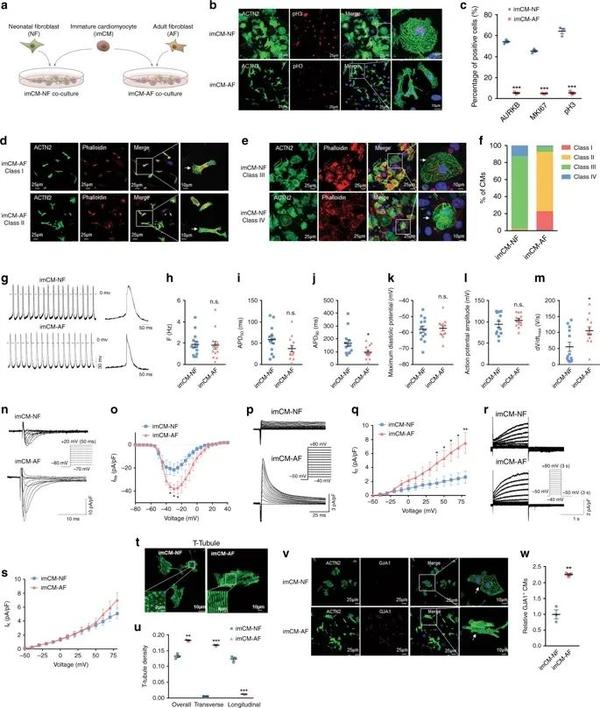
a Schematic of in vitro co-culture of cardiomyocytes and cardiac fibroblasts. Freshly isolated immature CMs (imCMs) from P1 mouse hearts were immediately co-cultured with fibroblast monolayers from either neonatal (P1, NF) heart or adult (P56, AF) hearts, respectively.b Immunofluorescent staining against ACTN2 and pH3 in imCMs 3.5 days after co-culture. White arrows indicate cells with co-localization. Scale bars = 10 or 25 μm.c Quantification of ACTN2+AURKB+, ACTN2+MKI67+, and ACTN2+pH3+ cells 3.5 days after co-culture.d, e Immunostaining against ACTN2 and Phalloidin in co-cultures. Representative images to show typical class I–II (d) and class III–IV (e) CM morphology, respectively.f Quantification of d, e.g Representative action potential tracings of imCMs in co-culture.h–m Quantification of beating frequency (h), action potential duration to 50 and 90% repolarization (APD50, i; APD90, j), maximum diastolic potential (MDP, k), action potential amplitude (APA, l), and maximum rate of rise (dV/dtmax) of action potential (m) of co-cultured imCMs. n = 13 cells.n Representative INa tracings of imCMs in co-culture with voltage control.o Quantification of n. n = 12 cells in imCM-NF = 13 cells in imCM-AF.p Representative Ito tracings of imCMs in co-culture.q Quantification of Ito (p) n = 11 cells.r Representative Ik tracings of imCMs in co-culture.s Quantification of IK in r. n = 10 cells in imCM-NF = 15 cells in imCM-AF (r).t Representative images to show T-tubule structure in imCMs in co-culture. T-tubule was labeled by di-8-ANEPPS.u Quantification of T-tubule density in t. Image J was applied in quantification.v Immunofluorescent staining of ACTN2 and GJA1 in imCMs 3.5 days into co-culture. White arrows indicate co-localized cells. Scale bar = 10 or 25 μm.w Quantification of v. All data in this figure are plotted as mean ± SEM from three biologically independent experiments, **p* < 0.05, ***p* < 0.01, ****p* < 0.001, n.s. not significant, two-sided Student’s t-test. Source data are provided as a Source Data file.
体内和体外CM成熟的分子相似性
为了观察与AFs共培养的imCMs形态和功能成熟的分子事件,研究团队分别对与NFs(imCM-NF组)或AFs(imCM-AF组)共培养的imCMs进行了RNA-Seq。典型的未成熟心脏基因,例如Acta1,是imCM-AF中被下调的基因之一,而与CM收缩性相关的基因(包括Myh6和Pln)则处于上调的基因组中(图5a)。AF共培养后上调基因的GO富集分析显示,脂肪酸代谢和肌肉细胞分化显着富集,这是成熟CM的主要特征(图5b)。相反,下调的基因在与细胞外基质(ECM)组织、血管生成等相关的生物过程中显着富集(图5c)。为了进一步证实与AF共培养的imCM的成熟趋势,研究团队采用了从P1(未成熟),P21(成熟)和P56(完全成熟)心脏分离的CM的大量RNA-Seq数据作为差异表达的参考数据集基因(DEG)。令人惊讶的是,在体内CM成熟期间上调的基因与imCM-NF相比,在imCM-AF中也显示出相似的增加模式(图5d)。尽管在较小程度上,这同样适用于体内成熟过程中下调的基因(图5e,f)。此外,GSEA富集分析表明(一文掌握GSEA,超详细教程),在imCMs-AF中上调的基因大量富集在成熟心脏中高表达的基因(P56),而下调的基因则大量富集在未成熟心脏中高表达的基因(P1)(图5g,h)。总之,这些观察结果显著表明AF在分子水平上对CM成熟的促进作用。
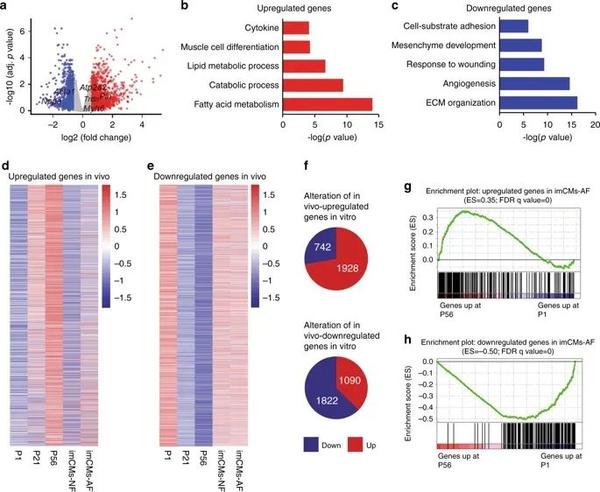
a Volcano plot to show DEGs in imCMs 3.5 days after co-cultured with NFs or AFs. Red indicates upregulated genes, and blue represents downregulated genes upon AF co-culture compared to imCM-NF (Supplementary Data 25(https://www.nature.com/articles/s41467-020-16204-w#MOESM28)).b, c Gene ontology analyses of upregulated (b) or downregulated (c) genes from a. Selected top categories are shown.d, e Heatmaps to show the expression of upregulated (d) or downregulated (e) genes during postnatal heart maturation in imCMs co-cultured with NFs vs. AFs. Please see Supplementary Data 26(https://www.nature.com/articles/s41467-020-16204-w#MOESM29) for the full list.f Top: number of genes upregulated or downregulated in vitro among upregulated genes in vivo (d); bottom: Number of genes upregulated or downregulated in vitro among downregulated genes in vivo (e).g Gene Set Enrichment Analysis (GSEA) showing that genes upregulated upon AF co-culture were enriched for genes that were highly expressed in P56 vs. P1 CMs.h Gene Set Enrichment Analysis (GSEA) showing that genes downregulated upon AF co-culture were enriched for genes that were highly expressed in P1 vs. P56 CMs.
识别CM成熟中的保守信号通路
作者然后对共培养细胞进行单细胞分析,并描述其成熟轨迹(图6a-b)。在伪时序分析中,发现共分为5个states(图6c-d)。正如预期,两组分布沿轨迹进行, 特别是,与NFs共培养的imCMs在state 1富集,大多数与AFs共培养的imCMs定位在State 5(图6c-e)。沿轨迹进行的DEG分析(DESeq2差异基因分析和批次效应移除)显示,关键信号传导途径的激活显着富集,包括粘附、ECM-受体相互作用和趋化因子信号传导途径(图6f,g)。
为了全面了解成纤维细胞对CM成熟的贡献,研究团队在编码成纤维细胞中分泌蛋白的特定基因与CM成熟相关的信号传导途径之间建立了推测的相关图(图6h,i)。作者预计主要存在于成年心脏中的EGR1High成纤维细胞(体内FB_4和体外coAF_2)在分泌可能促进CM成熟的蛋白质中起主要作用(图6i)。此外,为了确定在CM成熟中高度保守且至关重要的关键途径和分泌的蛋白质,研究团队比较了体内和体外CM成熟的概况,并观察到了预期的信号传导途径有明显重叠,例如趋化因子信号传导途径和ECM-受体相互作用,以及配体,例如Cxcl12。这些观察结果表明,AF在体外诱导CM成熟的机制与生理条件非常相似。
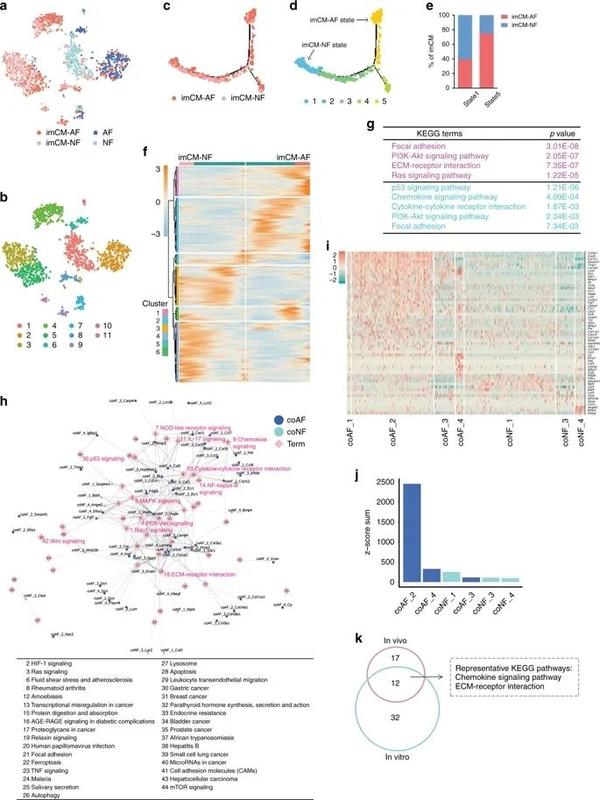
a, b t-SNE clustering of cells in both imCM-NF and imCM-AF co-culture systems by cell type (a) or cell subcluster (b).c, d Monocle analyses showing the ordering of imCMs co-cultured with NFs or AFs in pseudotime, marked by input cell type (c) or cell state (d). Arrows in d indicate representative state of imCM-NF or imCM-AF.e Percentages of imCM distribution in different cell states (d).f Heatmap to display differentially expressed genes (DEGs) along the pseudotime trajectory (d) (Supplementary Data 27(https://www.nature.com/articles/s41467-020-16204-w#MOESM30)).g Selected top Kyoto Encyclopedia of Genes and Genomes (KEGG) terms related to corresponding DEGs significantly changed during cardiomyocyte maturation in co-culture. Functional analysis was performed with enrichKEGG in clusterProfiler, p < 0.05 was considered significant enrichment.h Correlation analysis to show potentially matched pairs between the ligands secreted by representative cell clusters and signaling pathways in CM maturation (g) in the co-culture system. Each pink diamond represents signaling pathway (Supplementary Data 28(https://www.nature.com/articles/s41467-020-16204-w#MOESM31)). Each circle/dot indicates a secretory protein from a given cell type. Each connecting line indicates the correlation between a given secretory protein and a specific pathway.i Heatmap displaying the expression of genes indicated in correlation analysis (h) across all representative cell clusters (Supplementary Data 29(https://www.nature.com/articles/s41467-020-16204-w#MOESM32)).j Sum of all matched ligands (i) expressed in indicated cell clusters.k Venn diagram to show overlapping signaling pathways involved in cardiomyocyte maturation between heart development in vivo and in vitro co-culture (Supplementary Data 30(https://www.nature.com/articles/s41467-020-16204-w#MOESM33)). Representative 2 overlapping pathways are listed.
靶向抑制保守信号通路会损害成熟
为了验证CM成熟中的关键分子和信号传导途径,研究团队首先沉默了与AFs诱导的体外心肌成熟密切相关的分泌蛋白编码基因,如AF中的Dcn。AF中Dcn的沉默显着损害了AFs诱导的CM成熟,其特征是保留的增殖能力和缺乏丝状排列(图7a-d)。然后作者试图使用抑制剂来靶向多个相关基因融合的2条信号通路,并将抑制剂注入新生小鼠体内,发现这样可以明显抑制CM的成熟(图7e-g),但在成年小鼠中的抑制剂对心脏功能的影响有限。
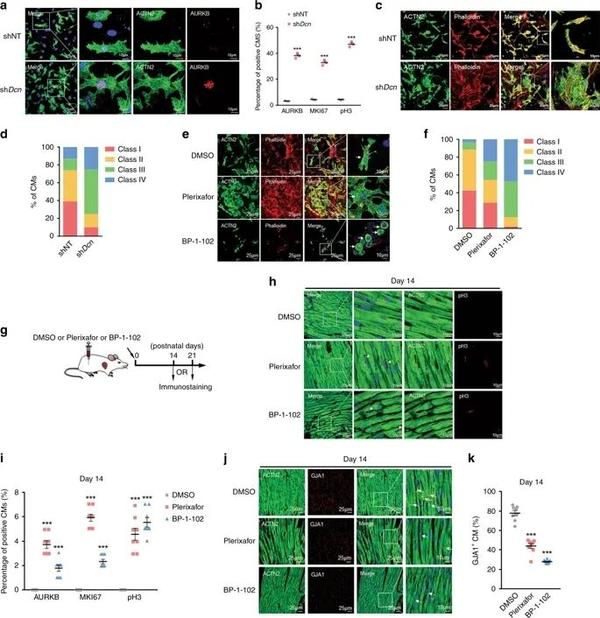
a Immunofluorescent (IF) staining against ACTN2 and AURKB in imCMs-AF upon transfection with shNT and shDcn, respectively. Scale bars = 25 or 10 μm.b Quantification of ACTN2+AURKB+ (a), ACTN2+MKI67+ (Supplementary Fig. 5b)(https://www.nature.com/articles/s41467-020-16204-w#MOESM1)) or ACTN2+pH3+ (Supplementary Fig. (5c)(https://www.nature.com/articles/s41467-020-16204-w#MOESM1)). Data are plotted as mean ± SEM from three independent experiments, ****p* < 0.001, two-sided Student’s t-test.c Immunostaining against ACTN2 and Phalloidin in imCMs 3.5 days after co-culture with AFs upon depletion of NT (shNT) or Dcn (shDcn), respectively.d Percentages of CMs in different morphology grades in c.e Immunostaining against ACTN2 and Phalloidin in imCMs 3.5 days after co-culture with AFs in the presence of DMSO, Plerixafor or BP-1-102, respectively.f Percentage of CMs in different morphology grades in e.g Workflow of animal experiment. Neonatal (P1) mice were treated with DMSO, Plerixafor or BP-1-102 daily for 14 (Day 14) or 21 days (Day 21), respectively. Mice were sacrificed for immunostaining of heart sections at P14 or P21, respectively.h Immunofluorescent staining against ACTN2 and pH3 in heart sections from mice at P14. White arrows indicate co-localization. Scale bar = 10 or 25 μm.i Quantification of ACTN2+AURKB+, ACTN2+MKI67+, and ACTN2+pH3+ cells. Data are plotted as mean ± SEM, n = 8 biologically independent mice, ****p* < 0.001, two-sided Student’s t-test.j Immunofluorescent staining of ACTN2 and GJA1 in heart sections of mice treated with DMSO, Plerixafor or BP-1-102 for 14 days, respectively. White arrows indicate co-localization. Scale bars = 10 or 25 μm.k Quantification of ACTN2+GJA1+ cells in j, Data are plotted as mean ± SEM, n = 8 biologically independent mice, **p < 0.001, two-sided Student’s t*-test. Source data are provided as a Source Data file.
通路抑制可在心脏受伤时逆转CM成熟
作者制造了一个心肌梗死的模型,然后马上使用抑制剂Plerixafor或BP-1-102进行治疗(图8a),结果发现与DMSO对照组相比,Plerixafor和BP-1-102均显着改善了心脏功能,并增加了梗塞区域边界区域的CM增殖(AURKB+,MKI67+和pH3+ -CM)(图8b-f)。
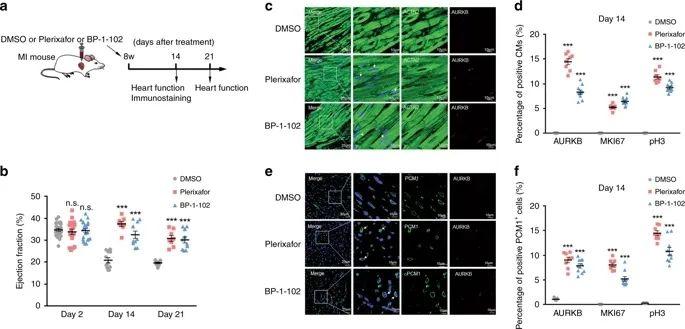
a Workflow of animal experiment. Eight-week-old mice were subjected to myocardial infarction (MI) surgery, and corresponding inhibitors or DMSO were administered immediately afterwards. Mice were sacrificed 14 days post surgery, and hearts were removed for immunostaining. The additional set of mice was monitored for cardiac function on days 2, 14, and 21.b Quantification of ejection fraction based on echocardiogram. Data are plotted as mean ± SEM, n = 23, 18, 20 biologically independent mice in DMSO, Plerixafor and BP-1-102 group at Day 2, respectively, n = 11, 8, 10 biologically independent mice in DMSO, Plerixafor and BP-1-102 group at Day 14 and Day 21, respectively. ****p* < 0.001, n.s. not significant, two-way ANOVA.c Immunofluorescent staining against ACTN2 and AURKB in the border zones of infarcts from (a). White arrows indicate co-localized cells. Scale bars = 10 or 25 μm.d Quantification of ACTN2+AURKB+ and ACTN2+MKI67+, and ACTN2+pH3+ cells. Data are plotted as mean ± SEM, n = 11, 8, 10 biologically independent mice in DMSO, Plerixafor and BP-1-102 group, respectively. ****p* < 0.001, one-way ANOVA.e Immunofluorescent staining against PCM1 and AURKB in the border zones of infarcts from a. White arrows indicate co-localized cells. Scale bars = 10 or 25 μm.f Quantification of PCM1+AURKB+ and PCM1+MKI67+, and PCM1+pH3+ cells. Data are plotted as mean ± SEM, n = 11, 8, 10 biologically independent mice in DMSO, Plerixafor and BP-1-102 group, respectively. ****p* < 0.001, one-way ANOVA. Source data are provided as a Source Data file.
FB在人类细胞模型中的保守作用
人多能干细胞衍生的心肌细胞(hPSC-CM)对于心脏再生医学具有广阔的前景。然而,它们的不成熟特性仍然是其临床应用中的主要障碍。鉴于成年小鼠心脏成纤维细胞在心肌细胞成熟中的主要作用,作者思考人成年心脏成纤维细胞是否也能够促进hPSC-CMs的成熟。
首先作者分离了人类成年心脏成纤维细胞(hAFs),并将其与人类胚胎干细胞衍生的CMs(hESC-CMs)共培养(图9a)。尽管大多数hESC-CMs高度增殖,如高表达AURKB+,MKI67+-和pH3+ -CM,但与hAFs共培养的CMs的增殖能力却显着下降(图9b,c)。
此外,与hAFs共培养还可以显着促进CM的形态成熟(图9d,e,补充图9c)。在转录水平,hAF共培养显着诱导了包括MYH6和TNNT2在内的心脏基因的表达,并抑制了MKI67和AURKB等增殖基因的表达(图9f)。对上调基因的GO分析显示,与肌肉系统过程和心脏收缩有关的生物学行为得以富集,而下调的基因则在DNA复制和核分裂中显著丰富,表明CM趋于成熟(图9g)。
值得注意的是,Plerixafor和BP-1-102未能抑制共培养诱导的hESC-CM成熟,提示不同物种在AF诱导的CM成熟中信号通路存在差异。在电生理活动中发现共培养后电生理成熟的趋势,并且使用钙通道阻滞剂硝苯地平来评估其对细胞外场电势(EFP),阻抗和跳动率的反应,也发现CM成熟的表型。
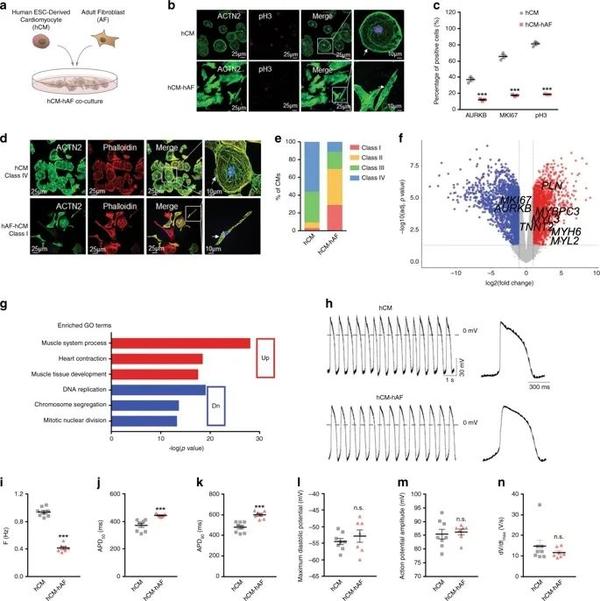
a Schematic of co-culture of human cells in vitro. Cardiomyocytes induced from human embryonic stem cells (hESC-CMs) were co-cultured on a monolayer of cardiac fibroblasts isolated from adult human heart (hAFs).b Immunofluorescent staining against ACTN2 and pH3 in hESC-CMs 7 days after co-culture with or without hAFs, respectively. White arrows indicate co-localized cells. Scale bars = 10 or 25 μm.c Quantification of ACTN2+AURKB+, ACTN2+MKI67+, and ACTN2+pH3+ cells.d Immunostaining against ACTN2 and Phalloidin in the co-culture system. Representative images to show typical class I and class IV hESC-CM morphology when co-cultured with or without hAF, respectively.e Percentage of CMs in different morphology grades.f Volcano plot to show DEGs in hESC-CMs only versus those co-cultured with hAF. Red indicates upregulated genes, and blue represents downregulated genes upon AF co-culture.g Gene ontology analyses of upregulated or downregulated genes (f). Selected top categories are shown.h Representative action potential tracings of hESC-CMs alone or in co-culture with hAFs, respectively.i–n Quantification of beating frequency (i), action potential duration to 50% repolarization (APD50, j), to 90% repolarization (APD90, k), maximum diastolic potential (MDP, l), amplitude of action potential (APA, m), and maximum rate of rise (dV/dtmax) of action potential (n) in (h). n = 8 cells in hCM, = 7 cells in hCM-hAF. All data in this figure are plotted as mean ± SEM from three biologically independent experiments, **p < 0.001, n.s. not significant, two-sided Student’s t*-test. Source data are provided as a Source Data file.
代码特色解析
嘻嘻,我当然会看作者在code availability中公布了哪一部分的代码,我们发现作者在Cell–cell interaction network analysis(https://github.com/LiWangLab/Cardiomyocyte_Maturation/blob/master/cross_match.r)中的分析思路如下:
获得小鼠分泌蛋白基因:在UniProt database中进行检索获取,locations:(location:“Secreted [SL-0243]”) AND reviewed:yes AND organism: “Mus musculus (Mouse) [10090]”. A total of 1503 genes were retrieved as secreted genes.
获取小鼠膜蛋白基因:Membrane protein keywords: annotation:(type:transmem) goa:(“plasma membrane [5886]”) AND reviewed:yes AND organism: “Mus musculus (Mouse) [10,090]”. A total of 1509 genes were retrieved as membrane genes.
使用Seurat中的FindAllMarkers function查找高变基因,选择编码分泌蛋白的基因作为可能的配体。
使用Program kg (https://github.com/endrebak/kg )获取KEGG pathways、their definitions and their related genes. 在P1-P56中CM的DEG与部分通路基因重叠,仅保留重叠的和相应的配体,并进行绘图。
哇,新冠的许多机理都仍然未知,我要是你,肯定是要看看这些分泌蛋白的相互作用呢!
文章解读:Tiger
参考文献
Wang Y, Yao F, Wang L, et al. Single-cell analysis of murine fibroblasts identifies neonatal to adult switching that regulates cardiomyocyte maturation. Nat Commun. 2020;11(1):2585. Published 2020 May 22. doi:10.1038/s41467-020-16204-w
你可能还想看
https://wap.sciencenet.cn/blog-118204-1241282.html
上一篇:Seurat的单细胞免疫组库分析来了!
下一篇:哈佛大学单细胞课程:笔记汇总前篇